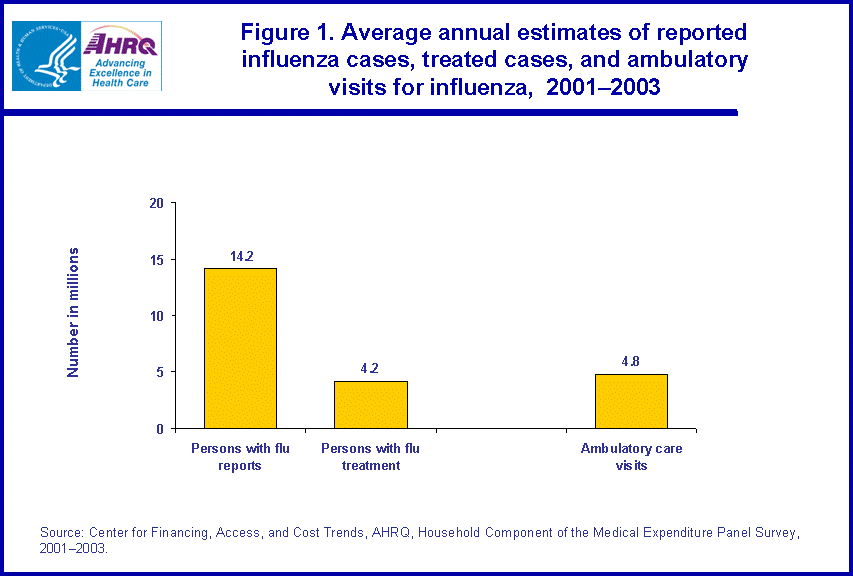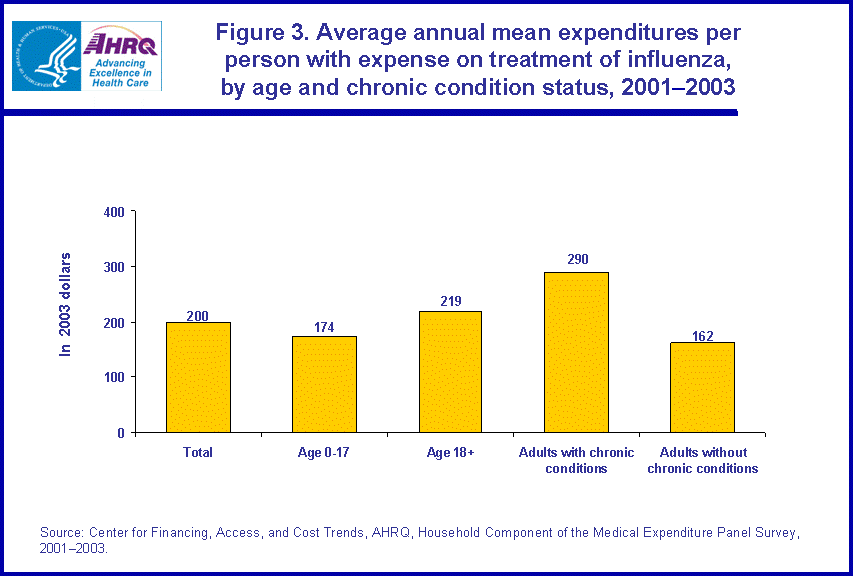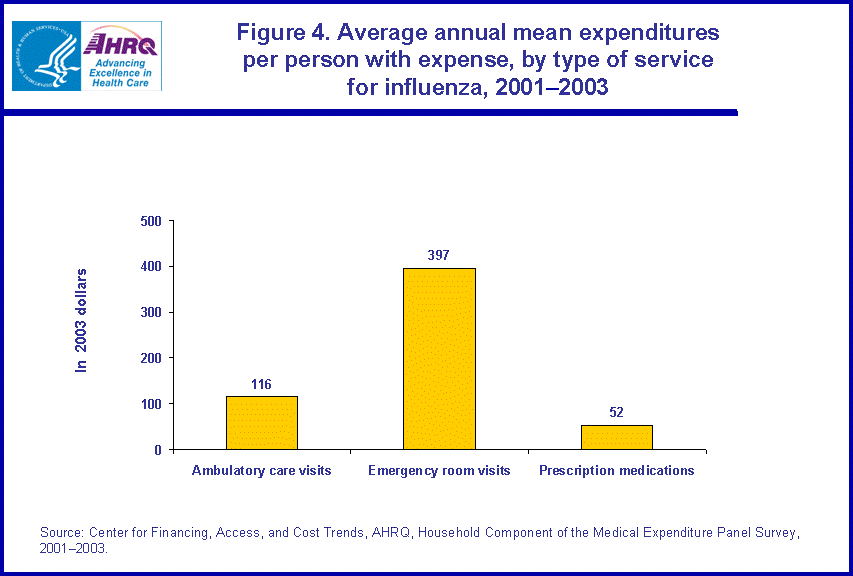
|
|
Font Size:
|
||||
|
|
|
|
||||
STATISTICAL BRIEF #116:
Average Annual Health Care Use and Expenses for Influenza, 2001-2003
Highlights
- On average in 2001-2003, 14.2 million persons contracted the flu. Of these, 30 percent (4.2 million) sought medical treatment.
- Medical spending to treat influenza totaled on average $850 million/year for 2001-2003 (in 2003 dollars).
- For 2001-2003, there was an annual average of 4.8 million ambulatory care visits for the treatment of influenza.
- Children were twice as likely to be treated for influenza as adults (2.4 percent of children versus 1.2 percent of adults).
- Having a chronic condition did not increase the likelihood of seeking treatment for the flu, but average yearly expenditures to treat adults with chronic condition for influenza were over twice as high as for those not having those conditions ($290 versus $162).
- In 2001-2003, the average mean annual expenditure per person to treat influenza (in 2003 dollars) was $52 for prescribed drugs, $116 for ambulatory visits, and $397 for emergency room visits among people who used prescription drugs, had ambulatory visits, and had emergency room visits, respectively.
Introduction
Influenza, also known as flu, is a viral infection in the nose, throat, and lungs caused by a number of different strains of the influenza virus. For the very young, those with chronic conditions, those with compromised immune systems, and the elderly, influenza often requires treatment by a health care professional.
This Statistical Brief presents estimates based on the Household Component of the Medical Expenditure Panel Survey (MEPS-HC) on health care use and expenditures for influenza treatment among the U.S. civilian noninstitutionalized population. Average annual estimates (in 2003 dollars) for the period 2001-2003 are shown by age, chronic condition status for adults, and type of service. The brief highlights chronic condition status for adults because people with chronic conditions (such as heart disease, asthma, and diabetes) are at greater risk for influenza complications. Data for three years were combined to improve the precision of the estimates, and expenditure data for 2001 and 2002 were adjusted to 2003 dollars using the Gross Domestic Product medical care price deflator. All differences between estimates noted in the text are statistically significant at the 0.05 level or better.
Findings
Number of reported cases, total average health care use, and expenditures for flu
In 2001-2003, an annual average of 14.2 million persons contracted the flu. Of these, 30 percent (4.2 million) sought medical treatment (figure 1). There was an annual average of 4.8 million ambulatory care visits for the treatment of influenza. From 2001-2003, an average of $850 million per year (in 2003 dollars) was spent on health care for influenza (estimate not shown).
Health care use for influenza, by age and chronic condition status
During 2001-2003, an annual average of 1.5 percent of the population reported treatment of influenza (figure 2). Children were twice as likely to be treated for influenza as adults (2.4 percent of children versus 1.2 percent of adults). The probability of being treated for influenza did not vary significantly between adults with or without chronic conditions.
Average mean health care expenditures for flu, by age and chronic condition status
Among those who received treatment for influenza, $200 per person (in 2003 dollars), on average, was spent on treatment (figure 3). Average expenditures to treat adults (age 18 and older) with chronic conditions for influenza were greater than average expenditures to treat adults without chronic conditions for influenza ($290 versus $162). Mean expenditures for influenza did not vary significantly between adults and children.
Average mean health care expenditures, by type of service for flu
Among those with an emergency room visit related to influenza, $397 per person (in 2003 dollars), on average, was spent on emergency room visits (figure 4). The mean expenditure for ambulatory visits was $116 for those who had an influenza-related ambulatory care visit. An average of $52 was spent per person on the prescription medicines for influenza-related treatment among those who received prescription medications for influenza treatment. Over-the-counter drugs that are commonly used to treat the flu are not included in these estimates because information about them is not ascertained in MEPS.
Data Source
The estimates shown in this Statistical Brief are based on data from the MEPS 2001, 2002, and 2003 Full Year Consolidated Files (HC-060, HC-070, and HC-079), Medical Condition Files (HC-061, HC-069, and HC-078), Office-Based Medical Provider Visit Files (HC-059G, HC-067G, and HC-077G), Outpatient Department Visits Files (HC-059F, HC-067F, and HC-077F), Emergency Room Visit Files (HC-059E, HC-067E, and HC-077E), and Prescribed Medicine Files (HC-059A, HC-067A, and HC-077A).
Definitions
Influenza or flu
This brief analyzes individuals with influenza reported as a condition bothering the person and influenza reported in connection with reported health care utilization (e.g., a person who reported purchasing a drug was asked what condition the drug intended to treat) or reported disability days. The conditions reported by the respondent were recorded by the interviewer as verbatim text, which was then coded by professional coders to fully specified ICD-9-CM codes. Conditions with an ICD9 code of 487 were classified as influenza.
Chronic conditions
Chronic conditions included in the analysis for adults are diabetes, asthma, and cardiovascular disease and stroke.
The indicator for cardiovascular disease and stroke was drawn from variables indicating presence of heart disease (coronary heart disease, angina, heart attack, stroke, or any other heart-related disease). For each of the conditions listed, the following question was asked: "(Have/Has) PERSON ever been told by a doctor or other health professional that PERSON had [condition]."
Expenditures
Payments from all sources for hospital inpatient care, ambulatory care provided in offices and hospital outpatient departments, care provided in emergency departments, as well as prescribed medicine purchases reported by respondents in the MEPS-HC. Sources include direct payments from individuals, private insurance, Medicare, Medicaid, Workers' Compensation, and miscellaneous other sources. Expenditure data for 2001 and 2002 were adjusted to 2003 dollars using the Gross Domestic Product medical care price deflator (Bureau of Economic Analysis).
About MEPS-HC
MEPS-HC is a nationally representative longitudinal survey that collects detailed information on health care utilization and expenditures, health insurance, and health status, as well as a wide variety of social, demographic, and economic characteristics for the civilian noninstitutionalized population. It is cosponsored by the Agency for Healthcare Research and Quality and the National Center for Health Statistics.
For more information about MEPS, call the MEPS information coordinator at AHRQ (301-427-1656) or visit the MEPS Web site at http://www.meps.ahrq.gov/.
References
For a detailed description of the MEPS survey design, sample design, and methods used to minimize sources of nonsampling error, see the following publications:
Cohen, J. Design and Methods of the Medical Expenditure Panel Survey Household Component. MEPS Methodology Report No. 1. AHCPR Pub. No. 97-0026. Rockville, Md.: Agency for Health Care Policy and Research, 1997.
Cohen, S. Sample Design of the 1996 Medical Expenditure Panel Survey Household Component. MEPS Methodology Report No. 2. AHCPR Pub. No. 97-0027. Rockville, Md.: Agency for Health Care Policy and Research, 1997.
Cohen, S. Design Strategies and Innovations in the Medical Expenditure Panel Survey. Medical Care, July 2003: 41(7) Supplement: III-5-III-12.
For more information about influenza, see the following publications:
Centers for Disease Control and Prevention. Influenza fact sheet: Key estimates about influenza and the influenza vaccine. Rev ed. Atlanta, Ga.: U.S. Department of Health and Human Services, Centers for Disease Control and Prevention: 2004. http://www.cdc.gov/flu/keyfacts.htm
Centers for Disease Control and Prevention. U.S. Influenza season summary. Atlanta, Ga.: U.S. Department of Health and Human Services. http://www.cdc.gov/flu/weekly/
Suggested Citation
Soni, A. and Hill, S. C. Average Annual Health Care Use and Expenses for Influenza, 2001-2003. Statistical Brief #116. March 2006. Agency for Healthcare Research and Quality, Rockville, Md. http://meps.ahrq.gov/mepsweb/data_files/publications/st116/stat116.shtml
AHRQ welcomes questions and comments from readers of this publication who are interested in obtaining more information about access, cost, use, financing, and quality of health care in the United States. We also invite you to tell us how you are using this Statistical Brief and other MEPS data and tools and to share suggestions on how MEPS products might be enhanced to further meet your needs. Please e-mail us at mepspd@ahrq.gov or send a letter to the address below:
Steven B. Cohen, PhD, Director
Center for Financing, Access, and Cost Trends
Agency for Healthcare Research and Quality
540 Gaither Road
Rockville, MD 20850
 |
||||||||||||||||||||||||
|
||||||||||||||||||||||||
|
|
||||||||||||||||||||||||
 |
||||||||||||||||||||||||
|
||||||||||||||||||||||||
|
|
||||||||||||||||||||||||
 |
||||||||||||||||||||||||
|
||||||||||||||||||||||||
|
|
||||||||||||||||||||||||
 |
||||||||||||||||||||||||
|
||||||||||||||||||||||||
|
|
||||||||||||||||||||||||


